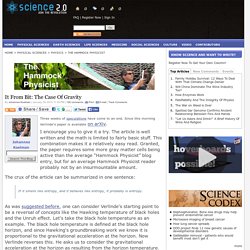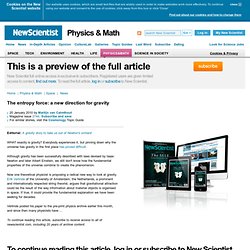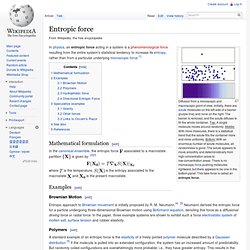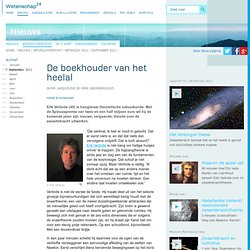

A Scientist Takes On Gravity. It From Bit: The Case Of Gravity. Three weeks of speculations have come to an end.

Since this morning Verlinde's paper is available on arXiv. I encourage you to give it a try. The article is well written and the math is limited to fairly basic stuff. This combination makes it a relatively easy read. Granted, the paper requires some more gray matter cells being active than the average “Hammock Physicist” blog entry, but for an average Hammock Physicist reader probably not by an insurmountable amount. The crux of the article can be summarized in one sentence: If it smells like entropy, and it behaves like entropy, it probably is entropy. As was suggested before, one can consider Verlinde's starting point to be a reversal of concepts like the Hawking temperature of black holes and the Unruh effect.
Subsequently, Verlinde takes a deep dive: if an acceleration is proportional to a temperature, it has all the characteristics of an entropic effect. Where represents the Newtonian gravitational potential. To be continued... The entropy force: a new direction for gravity - physics-math - Editorial: A gravity story to take us out of Newton's orchard WHAT exactly is gravity?

Everybody experiences it, but pinning down why the universe has gravity in the first place has proved difficult. Although gravity has been successfully described with laws devised by Isaac Newton and later Albert Einstein, we still don't know how the fundamental properties of the universe combine to create the phenomenon. Technology Review: Blogs: arXiv blog: Gravity Emerges from Quant. One of the hottest new ideas in physics is that gravity is an emergent phenomena; that it somehow arises from the complex interaction of simpler things.

A few month’s ago, Erik Verlinde at the the University of Amsterdam put forward one such idea which has taken the world of physics by storm. FQXiComm:Myth Gravity. The Myth of Gravity A new model in which gravity is not a fundamental force could—counterintuitively—give a controversial quantum gravity theory a boost. It may also change our picture of spacetime, and do away with dark energy. by Sophie Hebden. A New View Of Gravity. W24 - NU! Nederlander bedenkt revolutionaire zwaartekrachttheori. De Nederlandse Publieke Omroep maakt gebruik van cookies.

We maken een onderscheid tussen functionele cookies en cookies voor het beheer van webstatistieken, advertenties en social media. De cookies bevatten geen persoonsgegevens en zijn dus niet tot een individu te herleiden. NRC interview 2007. Entropic force. Diffusion from a microscopic and macroscopic point of view.

Initially, there are solute molecules on the left side of a barrier (purple line) and none on the right. The barrier is removed, and the solute diffuses to fill the whole container. Top: A single molecule moves around randomly. Middle: With more molecules, there is a statistical trend that the solute fills the container more and more uniformly. Ideal chain. An ideal chain (or freely-jointed chain) is the simplest model to describe polymers, such as nucleic acids and proteins. It only assumes a polymer as a random walk and neglects any kind of interactions among monomers. Although it is simple, its generality gives us some insights about the physics of polymers. In this model, monomers are rigid rods of a fixed length l, and their orientation is completely independent of the orientations and positions of neighbouring monomers, to the extent that two monomers can co-exist at the same place. The model[edit] N monomers form the polymer, whose total unfolded length is: , where N is the number of monomers.
In this very simple approach where no interactions between monomers are considered, the energy of the polymer is taken to be independent of its shape, which means that at thermodynamic equilibrium, all of its shape configurations are equally likely to occur as the polymer fluctuates in time, according to the Maxwell–Boltzmann distribution. Since and. Emergence.
In philosophy, systems theory, science, and art, emergence is a process whereby larger entities, patterns, and regularities arise through interactions among smaller or simpler entities that themselves do not exhibit such properties.

Emergence is central in theories of integrative levels and of complex systems. For instance, the phenomenon life as studied in biology is commonly perceived as an emergent property of interacting molecules as studied in chemistry, whose phenomena reflect interactions among elementary particles, modeled in particle physics, that at such higher mass—via substantial conglomeration—exhibit motion as modeled in gravitational physics. Neurobiological phenomena are often presumed to suffice as the underlying basis of psychological phenomena, whereby economic phenomena are in turn presumed to principally emerge. In philosophy, emergence typically refers to emergentism. In philosophy[edit] Dutch string theorist Erik Verlinde: gravity does not exist. The. Marie Curie. Colloquium Erik Verlinde.
Zware klap voor zwaartekracht. 23 augustus 2010 - Hoogleraar Theoretische Fysica Erik Verlinde (UvA) oogst internationale aandacht met een artikel waarin hij een nieuwe kijk op de zwaartekracht presenteert.

The entropic origin of gravity sur Flickr : partage de photos ! Introducing the Professor Doctor sur Flickr : partage de photos Yeah, what about it ? sur Flickr : partage de photos ! Multitasking sur Flickr : partage de photos ! That was elegant sur Flickr : partage de photos ! Folia 4 juni 2010 pp10-11. De boekhouder van het heelal. Sterrenstelsels draaien veel harder dan ze zouden moeten doen, en het heelal dijt sneller uit dan we op grond van de zichtbare materie kunnen verklaren.

Kosmologen zijn daarom naarstig op zoek naar de resterende 96 procent, die ze voor het gemak maar ‘donkere materie’ (20 procent) en ‘donkere energie’ (75 procent) hebben genoemd. Maar ze kijken daarbij de verkeerde kant op, zegt Verlinde. UvA - De zwaartekracht van Erik Verlinde.